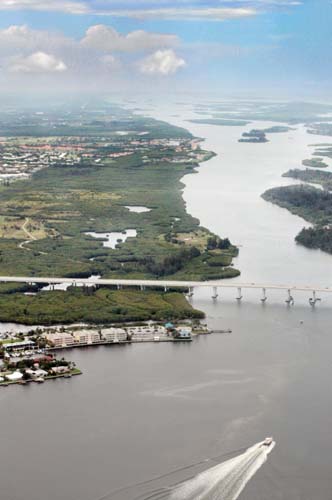INDIAN RIVER COUNTY — The Indian River Land Trust, which has emerged as one of the most effective conservation organizations in the state, has acquired a key 150-acre parcel on the west shore of the lagoon to the north of the Barber Bridge.
The acquisition, which closed May 15 after a year and a half of negotiations, comes shortly after the trust’s purchase of an adjacent 56-acre property in April.
Together, the two parcels include more than 200 acres of environmentally-critical land and more than a mile of lagoon shoreline, that in their natural state will help protect the estuary from polluted runoff and preserve irreplaceable fish-breeding habitat.
The latest transaction leaves only two parcels between the bridge and Grand Harbor in private, non-conservation hands: the small 17-acre property owned by Oculina Bank immediately south of Grand Harbor and a 27-acre parcel owned by Paul W. Hoffman that lies between county lands at the base of the bridge and the 200 acres acquired by the trust this spring.
“There aren’t many places you can go along the east coast of Florida where you can drive over a waterway such as the lagoon and look out on a long stretch of protected, green shoreline,” said trust Board Chairman Louis Schacht. “The Land Trust’s vision is to preserve this remaining undeveloped shoreline just as you see it today.”
The newly donated land comes with a $268,000 stewardship fund that will allow the trust to manage shoreline habitat and maintain the property in its pristine state.
An anonymous trust member donated $150,000 of the fund. The balance was given by Craig Chown, a Tallahassee resident who was one of the owners of the 150-acre property.
The previous purchase was made possible by donations from Dace and King Stubbs and Sally and Dick Brickman, long-time trust supporters.
This spring’s land preservation successes follow a series of earlier conservation accomplishments by the trust, which was founded in 1990 to help save McKee Botanical Gardens, a 10-year, $10-million project.
Following that endeavor, the trust was instrumental in preserving 2,000 acres of agricultural land from development.
In 2004, it led the effort to pass a $50-million land and water protection bond issue referendum that was approved by 67 percent of voters, enabling the county to purchase a number of properties for conservation.
With land prices skyrocketing, the county rushed to buy property before it became still more expensive and ended up spending the $50 million at or near the peak of the boom. That miscalculation by the county magnifies the importance of the trust’s efforts.
“The Land Trust has taken up the cause the county had taken up when it had funding through the bond referendum,” said County Environmental Planning Chief Roland DeBlois. “We have pretty much run out of money and the Land Trust has become the primary agency or non-profit out there buying and conserving land these days. They are definitely filling an important need.”
“In January 2009, our board recognized we had a historic opportunity to protect the lagoon and habitat near it,” said Grudens. “Because of the real estate downturn and failed developments along the water, extraordinary pieces of land were potentially available for conservation that would have been out of reach before.”
Since shifting its focus to protecting estuarine acreage four years ago, the trust has raised more than $8 million and permanently preserved more than eight miles of shoreline and nearly 900 acres of environmentally sensitive property critical to the well being of the lagoon.
“We really support what they are doing, getting private money to purchase conservation lands,” said Richard Baker, president of the Pelican Island Audubon Society. “Besides protecting water quality, the mangroves and salt marshes they are saving are critically important nurseries for game fish and without them our whole sport fishing industry will collapse.”
“They are doing a wonderful job of conserving properties that might otherwise be developed,” said Warren Falls, managing director of ORCA – the Ocean Research and Conservation Association – which is leading the effort to map pollution in the lagoon. “By maintaining natural vegetation along the shore, they help protect the lagoon from polluted runoff. I hope they keep doing what they are doing.”

